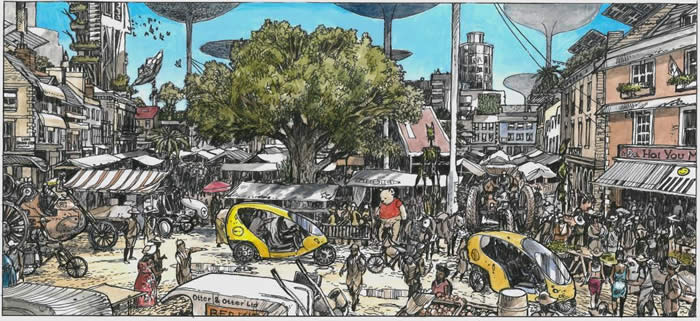The current state of climate change looks, for lack of a better word, bleak. Considering the recent shifts in the political and social agenda, climate change is pretty much at the bottom of the list for a lot of western civilization, at least for the time being. The majority of predictions concerning the future paint a destitute wasteland resembling a scene from any one of the ever-so popular dystopian branch of entertainment. It is, therefore, unsurprising that a negative frame of mind is adopted when considering climate change – as far as anyone is concerned we are already doomed, right? But what if this wasn’t the case and instead we look forward with positivity and actively pursue a better future, for both ourselves and future generations.
This is the concept behind a graphic novel recently produced by a team at the University of Leeds. In a collaborative effort with climate change scientists, PhD students, contributions from school children and art from comic artists, this project aimed to create a positive vision of the future of climate change. The project was carried out by students and staff at the Centre for Doctoral Training in Low Carbon Technologies and Bioenergy at the University of Leeds using workshops with local people to create ideas of a sustainable and, more importantly, an optimistic vision of the future.
The novel focuses on the UK, in particular the Yorkshire area, and imagines a future where having lived through an energy crisis, or as it is called in the novel the “energy descent,” humans came together to create a future where we not only prevent climate change but are retrospectively fixing the damage done by fossil fuels.
When people are asked to think of a positive future for the human race (no dystopian nightmares allowed) images of flying cars and telekinesis comes to mind. In contrast, the novel presents text and images which create a much more realistic potential future. The technologies which are described are entirely based on climate technology which already exists or research which is currently being conducted, making the future they describe seem all the more grounded and realistic.
The story begins by describing the history of the earth and how the planet’s climate has changed since life first came to this little rock and how, since the dawn of humanity, our actions have changed the climate.
The story continues to outline the history of humanity’s industrial era, in particular the technology of our consumer culture and the way in which our reliance on fossil fuels resulted in high carbon emissions. Following this, the story then shifts from a historical perspective to a fictional one taking place in the future. Here, it describes and shows the innovations and changes humanity used to overcome climate change and actively reduce the damage done by our reliance on fossil fuels. Skipping ahead, and without going into the specifics, the story concludes with a rather inspiring outlook which suggests that the revolutionary change in climate change was made possible through the struggle of previous generations, in this case us. The story is presented as a non-linear narrative and while this jumping back and forth can occasionally make some of the content difficult to follow it doesn’t affect the overall enjoyment of the work. Likewise, the topic of climate change is hardly the most light-hearted and approachable subject; the story and science are described in immense detail, justifying the novel’s 96 pages. Nonetheless, the content, both artistic and written, is approachable to scientists and non-scientists alike and covers a range of topics, including future transport systems, the economy of climate change, food production and healthcare. Finally, while it occasionally delves into existentialism and makes you realise how terrible we are as a species, the overall effect is one that promotes a better vision of the future. It focuses on the positive change humanity is capable of and highlights the fact that, if we are willing to put the effort in, through innovation and determination we can make things better.
Overall, when it comes to climate change and science communication in general, we need more content like this, which is approachable and will increase the engagement of the wider populous, or we run the risk of falling behind in a field which is becoming more and more vital to humanity’s continued survival.
To read the graphic novel, click here.
Steven Gibney
(Image courtesy of University of Leeds)

